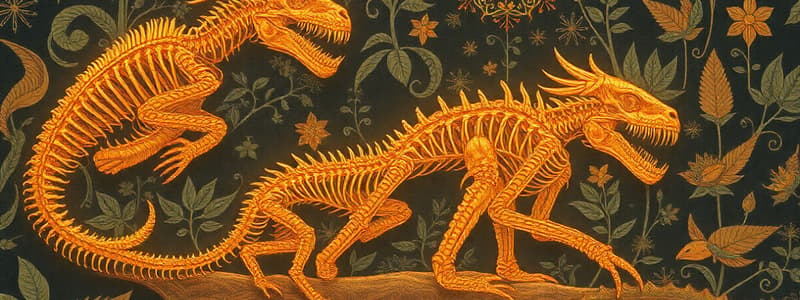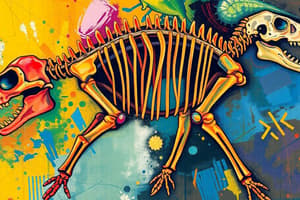Podcast
Questions and Answers
Which of the following defines evolution most accurately?
Which of the following defines evolution most accurately?
- A process that keeps genes unaltered across generations.
- A process that maintains the genetic material of a population over time.
- A process that prevents the emergence of new traits in a population.
- A process that causes changes in a population's genetic material over time. (correct)
Fossil records provide no evidence of evolutionary change.
Fossil records provide no evidence of evolutionary change.
False (B)
Which of the following is an example of homologous structures?
Which of the following is an example of homologous structures?
- The fins of a fish and the flippers of a whale.
- The thorns on a rose bush and the spines on a cactus.
- The bones in the forelimbs of humans, bats, and whales. (correct)
- The wings of a bird and the wings of a butterfly.
Structures that have different mature forms in different organisms but develop from the same embryonic tissue are called ______ structures.
Structures that have different mature forms in different organisms but develop from the same embryonic tissue are called ______ structures.
What are vestigial organs?
What are vestigial organs?
Similarities in early development among different species provide evidence for common ancestry.
Similarities in early development among different species provide evidence for common ancestry.
What is the name of the theory proposed by Jean-Baptiste de Lamarck regarding the inheritance of traits?
What is the name of the theory proposed by Jean-Baptiste de Lamarck regarding the inheritance of traits?
Match the following principles with Lamarck's theory of evolution:
Match the following principles with Lamarck's theory of evolution:
According to Lamarck's theory, how did giraffes develop long necks?
According to Lamarck's theory, how did giraffes develop long necks?
August Weismann's experiments supported Lamarck's theory of inheritance of acquired characteristics.
August Weismann's experiments supported Lamarck's theory of inheritance of acquired characteristics.
What was a key criticism of Lamarckism based on Weismann's theory?
What was a key criticism of Lamarckism based on Weismann's theory?
According to the August Weismann theory, the hereditary material is located in the ______.
According to the August Weismann theory, the hereditary material is located in the ______.
According to the postulates of Darwinism, What is geometric increase?
According to the postulates of Darwinism, What is geometric increase?
Darwin's theory of natural selection states that all individuals in a population are equally likely to survive and reproduce.
Darwin's theory of natural selection states that all individuals in a population are equally likely to survive and reproduce.
Darwin's finches are an example of:
Darwin's finches are an example of:
What is the term for the process where nature favors the survival and reproduction of individuals with advantageous traits?
What is the term for the process where nature favors the survival and reproduction of individuals with advantageous traits?
Match the evolutionary concepts with their descriptions:
Match the evolutionary concepts with their descriptions:
Mimicry and protective coloration are evidence in favor of:
Mimicry and protective coloration are evidence in favor of:
According to Darwin, variations are somatic variations
According to Darwin, variations are somatic variations
Which of the following is NOT a postulate of Darwinism?
Which of the following is NOT a postulate of Darwinism?
Darwin went to the voyage on H.M.S ______
Darwin went to the voyage on H.M.S ______
Which of the following describes homologous body structrues?
Which of the following describes homologous body structrues?
Analogous structures have different origin
Analogous structures have different origin
Which of the following is an example of vestigial organs
Which of the following is an example of vestigial organs
Define evolution
Define evolution
Which of the following is evidence of Evolution
Which of the following is evidence of Evolution
Lamarckism theory is the survival of the fittest or natural selection
Lamarckism theory is the survival of the fittest or natural selection
Vestigial organs have [blank] useful function.
Vestigial organs have [blank] useful function.
Give one example of vestigial organ
Give one example of vestigial organ
Flashcards
Evolution
Evolution
A process that causes changes in a population's genetic material over time, resulting in altered genes, new traits, and new species.
The Fossil Record
The Fossil Record
Layers of fossils show change over time.
Geographic Distribution
Geographic Distribution
Similar environments lead to similar types of organisms.
Homologous Structures
Homologous Structures
Signup and view all the flashcards
Analogous Structures
Analogous Structures
Signup and view all the flashcards
Vestigial Organs
Vestigial Organs
Signup and view all the flashcards
Similarities in Early Development
Similarities in Early Development
Signup and view all the flashcards
Jean-Baptiste de Lamarck
Jean-Baptiste de Lamarck
Signup and view all the flashcards
New Needs
New Needs
Signup and view all the flashcards
Use and Disuse of Organs
Use and Disuse of Organs
Signup and view all the flashcards
Inheritance of Acquired Characters
Inheritance of Acquired Characters
Signup and view all the flashcards
Speciation (Lamarckism)
Speciation (Lamarckism)
Signup and view all the flashcards
Giraffe Evolution (Lamarck's View)
Giraffe Evolution (Lamarck's View)
Signup and view all the flashcards
Snake Evolution (Lamarck's View)
Snake Evolution (Lamarck's View)
Signup and view all the flashcards
August Weismann's Theory
August Weismann's Theory
Signup and view all the flashcards
Darwinism (Natural Selection)
Darwinism (Natural Selection)
Signup and view all the flashcards
Geometric Increase
Geometric Increase
Signup and view all the flashcards
Struggle for Existence
Struggle for Existence
Signup and view all the flashcards
Variations
Variations
Signup and view all the flashcards
Natural Selection (Darwin)
Natural Selection (Darwin)
Signup and view all the flashcards
Inheritance of Useful Variations
Inheritance of Useful Variations
Signup and view all the flashcards
Speciation (Darwin)
Speciation (Darwin)
Signup and view all the flashcards
Giraffe Evolution (Darwin's View)
Giraffe Evolution (Darwin's View)
Signup and view all the flashcards
Parallelism
Parallelism
Signup and view all the flashcards
Evidences Against Darwinism
Evidences Against Darwinism
Signup and view all the flashcards
Study Notes
- Evolution is a process that causes changes in a population's genetic material over time
- Evolution can result in new species, altered genes, and new traits.
Evidence of Evolution
- The Fossil Record
- The Geographic Distribution of Living Things
- Homologous Body Structures
- Similarities in Early Development
The Fossil Record
- Layers show change
Geographic Distribution of Living Things
- Similar environments have similar types of organisms
Homologous Structures
- Have different mature forms or functions in different organisms
- Develop from the same embryonic tissue.
Analogous structure
- Structures have the same function but different origin
Vestigial organs
- Organs serve no useful function in an organism
- Examples include the appendix, miniature legs, or arms.
Early Development
- Development has similarities across comparative embryology, such as in fish, reptiles, birds and humans.
Jean-Baptiste de Lamarck (1744 - 1829)
- French naturalist
- Sought a naturalistic explanation for the diversity of modern organisms
- Proposed the Theory of Inheritance of Acquired Characters in 1809.
Postulates of Lamarckism
- New needs arise from changes in the environment, like light, temperature, etc
- Organisms exert special efforts to fulfill these new needs, like changes in habits or behavior.
- Use and disuse of organs is related to new habits. Greater use of certain organs occurs to meet new needs. Disuse of other organs happens when they are no use in new conditions.
- Lamarck believed favorable acquired characters are inheritable and are transmitted to offspring
- Offspring are born more fit to face new environmental conditions
- Lamarck believed new characters are acquired and transmitted every generation
- New characters accumulate each generation, and result in a new species after many generations
Lamarckism in Giraffes
- A deer-like quadrupedal was the ancestor to the modern giraffe
- Ground vegetation disappeared and trees became the only source of food
- Giraffes developed long necks and long fore-limbs since short-necked giraffes could not reach upper branches and did not survive to pass on their genes.
Lamarckism in Snakes
- Lizard-like reptiles with fully developed pentadactyl limbs were the ancestors of snakes
- Limbs fell into disuse and bodies were stretched to suit their creeping mode of local motion, evolving them into limbless snakes
Lamarckism in Horses
- Ancestors of modern horses (Equus caballus) used to live in areas with soft ground and were short-legged with more functional digits
- Gradually took to living in areas with dry ground
- The change was accompanied by the increase in leg length and decrease in functional digits for fast running over hard ground.
Criticism of Lamarckism
- August Weismann proposed the Theory of Continuity of Germplasm in 1892.
- A multicellular organism is formed of two types of cells: germ cells which have genes for inheritable characters, and somatic cells which have genes for particular organs during one's lifetime only
August Weismann Criticism Details
- Environment affects only somatic cells, and the link between generations is through germ cells
- Somatic cells are not transmitted to the next generation.
- Acquired characters are lost with the death of an organism and have no role in evolution.
- Pavlov trained mice to come for food on hearing a bell, but it was not inherited and replication was necessary each generation
- Kellogg and Bell fed larva of silk moths on reduced quantity of mulberry leaves, and found decreased larva size in next two generations even when these fed normally
- Castle and Philips transplanted the ovary of a black guinea pig into the body of a white guinea pig before sexual maturity and mated the female; observation shows the environment doesn't influence germ plasm.
Significance of Lamarckism
- It was the first comprehensive theory of biological evolution
- It nicely explains the existence of vestigial organs in animals due to their continuous disuse
- It explains the development of strong jaw muscles and claws in carnivores due to their continued extra use
- It stimulated other biologists to look for the mechanism of organic mechanism.
Darwinism (Theory of Natural Selection)
- Proposed by Charles Darwin (1809-1882 A.D.)
- He went on a voyage on H.M.S Beagle and explored S. America, the Galapagos islands and other islands
- Was highly influenced by essays 'On the Tendency of varieties on Depart Indefinitely from the original type" by Alfred Russell Wallace and 'Principle of geology” by Charles Lyell.
Postulates of Darwinism
- Geometric increase
- Limited food and space
- Struggle for existence
- Variations
- Natural selection or survival of the fittest
- Inheritance of useful variations
- Speciation
Darwinism on Giraffes
- Natural selection says the giraffes with short necks had less food to eat because the food resources changed to leaves only on the upper branches
- Short necks could not reach upper branches and did not survive to pass on their genes
- Long neck giraffes survived and reproduced because they were able to reach the food
Dawin's Finches
- Finches are an example of adaptive radiation
Evidence in Favour of Darwinism
- Close parallelism between natural selection and artificial selection
- Cases of resemblance such as mimicry and protective coloration
- Replacement of earlier giant dinosaurs by smaller carnivorous reptiles due to scarcity of food, space and global cooling
- The pedigree of horses and other animals supports Darwinism.
- The correlation between the position of nectaries in flowers and the length of the proboscis of pollinating insects, which can only be developed gradually.
Evidences Against Darwinism
- Inheritance of vestigial organs.
- Inheritance of over-specialized organs.
- He didn't explain the cause of variations and the mode of transmission of variations
- It doesn't include the transitional stages which have no fossil record
- Darwin didn't differentiate between somatic and germinal variations
- It doesn't explain the evolution of terrestrial animals from aquatic animals
Studying That Suits You
Use AI to generate personalized quizzes and flashcards to suit your learning preferences.




